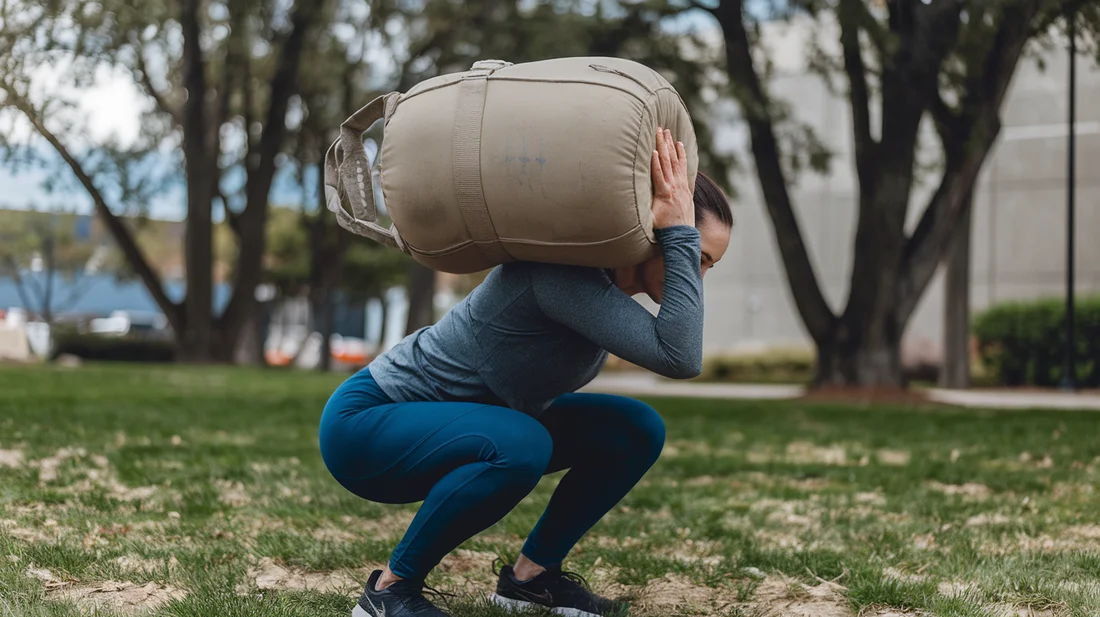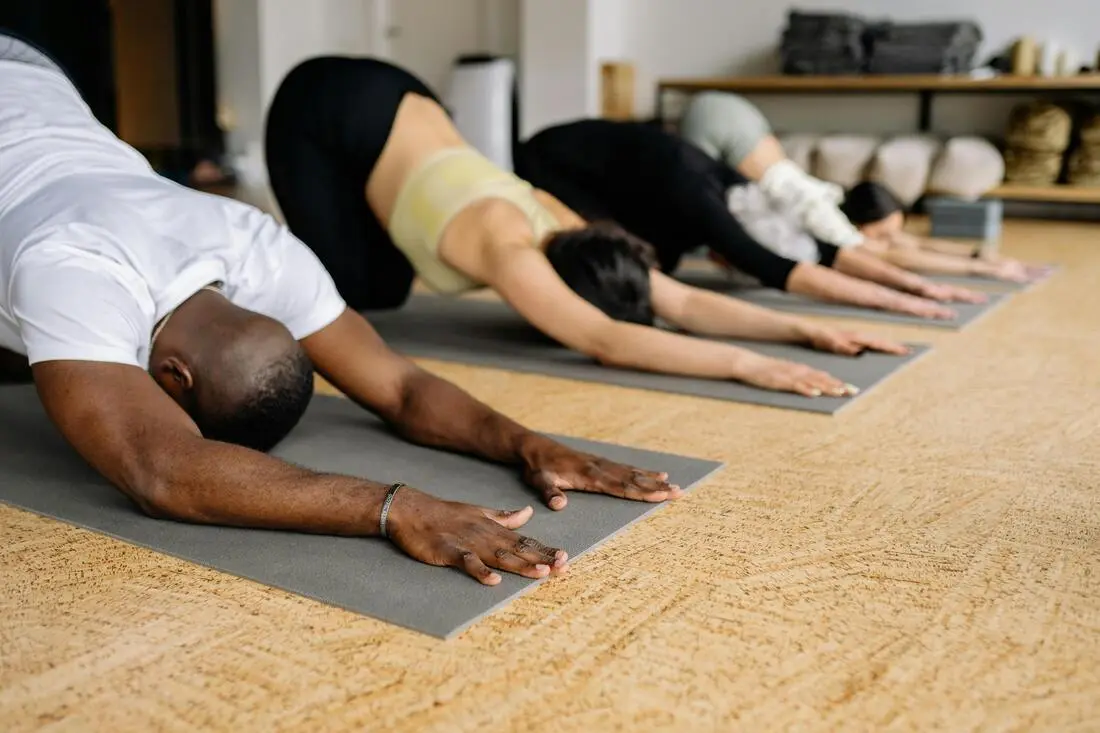Transform your body in just 30 minutes with sandbag circuit training!
No gym membership needed—just you, a sandbag, and a half-hour to torch fat and build functional strength.

If you’re ready for an effective workout that’s a step above the usual routine, here’s what to expect:
- Burns 300-400 calories: Get your heart racing and shed those calories fast!
- Full-body workout in 30 minutes: Target all major muscle groups in record time.
- Combines strength and cardio: Build muscle while boosting your cardiovascular fitness.
- Scalable for all fitness levels: Adjust weight and intensity to match your abilities.
What You’ll Need
Before diving into the workout, here’s your essential checklist:
- Sandbag: Start with a lighter weight if you’re new to ensure proper form.
- Exercise Mat: For comfort during floor exercises and better grip.
- Water Bottle: Stay hydrated with quick sips during your workout.
- Timer or Stopwatch: Track your intervals and rest periods effectively.
Who This Circuit Is For
This sandbag circuit suits everyone—from beginners to advanced athletes.
Whether you’re just starting, looking to mix things up, or challenging your strength, this workout is perfect for those busy days when you need an effective, quick solution.
Ready to get started? Let’s jump into the science behind sandbag training!
The Science Behind Sandbag Training

Why Sandbags Are Effective for Fat Loss
Sandbag training is a fat-burning powerhouse.
Unlike traditional weights, sandbags shift during workouts, creating an unstable environment that forces your muscles to engage more fully.
This increased intensity leads to a higher calorie burn in less time.
According to the National Institutes of Health (NIH) (.gov), Minimal resistance training improves daily energy expenditure and fat oxidation.
Muscle Recruitment Benefits
A key advantage of sandbag training is its ability to activate multiple muscle groups simultaneously.
As you lift a sandbag, stabilizing muscles are recruited to maintain balance, enhancing overall strength and functional fitness.
Research from the National Institutes of Health (NIH) (.gov), shows that Effect of an Unstable Load on Primary and Stabilizing Muscles During the Bench Press.
Metabolic Impact
Sandbag circuits not only build strength but also significantly boost your metabolism.
The intense nature of these workouts elevates post-exercise oxygen consumption (EPOC), often called the “afterburn effect,” where your body continues to burn calories long after you’ve finished exercising.
A study from the National Institutes of Health (NIH) (.gov), highlights the EPOC Comparison Between Resistance Training and High-Intensity Interval Training in Aerobically Fit Women can maximize calorie burn, even while you relax!
Getting Started
Ready to kick off your sandbag training journey?
Let’s ensure you’re set up for success by selecting the right sandbag weight and gathering essential equipment, along with vital safety tips to keep you injury-free.
Choosing Your Sandbag Weight
Selecting the appropriate sandbag weight is crucial for maximizing your workouts and maintaining proper form. Here’s a quick guide based on fitness levels:
Weight Recommendations Table
| Fitness Level | Recommended Weight (lbs) |
|---|---|
| Beginner | 10 – 20 lbs |
| Intermediate | 20 – 40 lbs |
| Advanced | 40 – 60+ lbs |
Tips: Start lighter if unsure, and consider adjustable sandbags for flexibility as you progress.
Essential Equipment Checklist
Besides your sandbag, gather these essentials to enhance your workout experience:
- Exercise Mat: For comfort during floor exercises.
- Water Bottle: Stay hydrated throughout.
- Towel: Wipe off sweat and stay dry.
- Timer/Stopwatch: Track intervals and rest periods.
Safety Considerations
Prioritize safety while training with sandbags. Keep these tips in mind:
- Warm-Up: Start with a dynamic warm-up to prepare your muscles (arm circles, leg swings, torso twists).
- Focus on Form: Proper form is more important than lifting heavier weights to avoid injuries.
- Listen to Your Body: Stop if you feel pain (not just normal workout discomfort).
- Space: Ensure you have enough room for all movements, especially those that involve swinging or lifting overhead.
Form Tips
For success in sandbag training, maintain good form with these tips:
- Engage Your Core: A strong core stabilizes your movements and reduces injury risk.
- Use Full Range of Motion: Focus on controlled movements rather than rushing through exercises.
- Breathe Properly: Exhale during exertion (lifting) and inhale while lowering.
- Watch Your Back: Keep your back straight and shoulders back to avoid strain, especially in deadlifts and squats.
With your equipment ready and safety tips in place, you’re all set to dive into the 30-minute sandbag circuit that will challenge your strength and ignite fat loss!
5-Minute Dynamic Warm-Up

Before diving into the ultimate sandbag circuit, it’s crucial to warm up your body.
A dynamic warm-up elevates your heart rate, boosts blood flow, and enhances overall performance while reducing injury risk.
Here’s a quick 5-minute routine to get you ready!
Warm-Up Exercises
- Arm Circles (1 minute)
- Stand tall with arms out to the sides.
- Make small circles, gradually increasing the size for 30 seconds each direction.
- Leg Swings (1 minute)
- Use a wall for support and swing one leg forward and backward for 30 seconds per leg.
- Torso Twists (1 minute)
- Stand with feet hip-width apart, knees slightly bent.
- Twist your torso gently left and right for 1 minute.
- Bodyweight Lunges (1 minute)
- Step forward into a lunge, keeping your knee aligned with your ankle.
- Alternate legs for 1 minute.
- Dynamic Squats (1 minute)
- Stand with feet shoulder-width apart.
- Lower into a squat while keeping your chest up, then push through your heels to stand back up for 1 minute.
Joint Mobility Exercises
- Hip Circles (30 seconds each leg)
- Stand tall and lift one knee, making small circles with your hip, gradually increasing the size.
- Ankle Rolls (30 seconds each foot)
- Lift one foot off the ground and roll your ankle in circles, then switch feet.
Dynamic Stretches
- Walking Toe Touches
- Step forward while reaching down to touch your toes, alternating legs as you walk.
- High Knees
- Jog in place, lifting your knees as high as possible to elevate your heart rate.
Practice Movements
- Sandbag Hold
- Pick up your sandbag and practice holding it in various positions (front rack, over the shoulder).
- Bodyweight Squats
- Perform a few bodyweight squats to reinforce proper form before adding the sandbag.
With your body warm and ready, you’re set to tackle the 30-minute sandbag circuit!
The Ultimate Sandbag Circuit Structure
Now that you’re warmed up, let’s dive into the ultimate 30-minute sandbag circuit designed to challenge your strength, boost cardiovascular fitness, and support your fat loss goals.
Here’s the structure:
Circuit Format
- Total Duration: 30 minutes
- Number of Exercises: 10
- Work Interval: 45 seconds of work followed by 15 seconds of rest
- Rounds: 3 rounds total
- Rest Between Rounds: 1 minute
This format keeps your heart rate elevated while maximizing workout efficiency. Let’s break down the exercises:
The Exercises

- Sandbag Squats
- Position: Feet shoulder-width apart, sandbag in front rack.
- Movement: Lower into a squat, keeping your chest up and knees behind toes.
- Tip: Engage your core and keep your back straight.
- Sandbag Clean and Press
- Position: Feet shoulder-width apart, sandbag on the ground.
- Movement: Bend to grab the sandbag, clean it to your shoulders, and press overhead.
- Tip: Drive with your legs and maintain a stable core.
- Sandbag Rows
- Position: Bend at the hips, holding the sandbag with both hands.
- Movement: Pull the sandbag towards your torso, squeezing shoulder blades.
- Tip: Keep your back flat and core engaged.
- Sandbag Lunges
- Position: Sandbag in the front rack.
- Movement: Step forward into a lunge, keeping your knee over your ankle.
- Tip: Maintain an upright upper body and engaged core.
- Sandbag Deadlifts
- Position: Feet hip-width apart, sandbag on the ground.
- Movement: Bend to lift the sandbag, keeping your back straight.
- Tip: Push through your heels and keep the sandbag close.
- Sandbag Shoulder Press
- Position: Sandbag resting on one shoulder.
- Movement: Press overhead until your arm is extended, then lower it.
- Tip: Keep your core tight and avoid arching your back.
- Sandbag Turkish Get-Up
- Position: Lie on your back with the sandbag overhead.
- Movement: Rise to standing while keeping the sandbag overhead, then return.
- Tip: Move slowly and maintain a strong core.
- Sandbag Carries
- Position: Stand tall, holding the sandbag at your side.
- Movement: Walk a set distance or time while maintaining good posture.
- Tip: Engage your core and keep shoulders back.
- Sandbag Slams
- Position: Stand with feet shoulder-width apart, holding the sandbag overhead.
- Movement: Slam the sandbag down with force, bending your knees.
- Tip: Generate power from your legs while maintaining a strong core.
- Sandbag Core Rotation
- Position: Stand with feet shoulder-width apart, sandbag at chest level.
- Movement: Rotate your torso side to side, engaging your core.
- Tip: Keep hips facing forward and use your core muscles.
Exercise Progression Chart
| Exercise | Beginner Variation | Intermediate Variation | Advanced Variation |
|---|---|---|---|
| Sandbag Squats | Bodyweight Squats | Sandbag Front Squats | Sandbag Overhead Squats |
| Sandbag Clean and Press | Sandbag Deadlifts | Clean to Shoulder Press | Clean and Press |
| Sandbag Rows | Single-Arm Rows | Double-Arm Rows | Bent-Over Rows |
| Sandbag Lunges | Static Lunges | Walking Lunges | Jumping Lunges |
| Sandbag Slams | Slams with Light Weight | Slams with Moderate Weight | Explosive Slams |
With these exercises set, you’re ready to tackle the ultimate sandbag circuit that will leave you feeling accomplished and energized!
Cool Down and Recovery

Cooling down after your workout is essential for gradually reducing your heart rate, promoting flexibility, and aiding muscle recovery.
Here are effective cool-down exercises and recovery tips to incorporate after your sandbag circuit.
Cool Down Exercises
- Gentle Walking (2-3 minutes)
After your circuit, take a slow walk to help your heart rate decrease and transition your body to rest. - Static Stretching (5-10 minutes)
Stretch the major muscle groups worked during your circuit, holding each stretch for 15-30 seconds:- Hamstring Stretch: Sit with one leg extended and reach towards your toes.
- Quadriceps Stretch: Stand on one leg, pulling the opposite foot toward your glutes.
- Chest Stretch: Clasp your hands behind your back and gently pull your shoulders back.
- Shoulder Stretch: Bring one arm across your body and press it gently with the opposite hand.
- Cat-Cow Stretch (1-2 minutes)
On all fours, alternate between arching your back (Cow) and rounding it (Cat) to release spinal tension. - Child’s Pose (1-2 minutes)
Kneel, sit back on your heels, and stretch your arms forward on the ground to relax your back and shoulders.
Recovery Tips
- Hydration: Drink plenty of water post-workout to replenish lost fluids.
- Nutrition: Refuel with a balanced meal or snack rich in protein and carbohydrates for muscle recovery.
- Rest: Allow adequate recovery time and incorporate rest days to prevent overtraining.
- Foam Rolling: Use a foam roller on sore muscles to release tension and improve blood flow.
- Sleep: Prioritize sufficient sleep each night, as this is crucial for muscle repair and recovery.
Incorporating these cool-down exercises and recovery tips will enhance your overall workout experience and support your fitness goals!
Frequently Asked Questions
As you embark on your ultimate sandbag circuit journey, here are answers to common questions to help you maximize your workouts.
How often should I do this circuit?
For optimal results, aim to perform this circuit 2 to 3 times per week. This frequency allows muscle recovery while providing enough stimulus for strength and fat loss. Always listen to your body and include rest days to prevent overtraining.
How heavy should my sandbag be?
Choosing the right weight is crucial for safety and effectiveness. Here’s a quick guide:
- Beginners: Start with 10-20 lbs to focus on form.
- Intermediate: Progress to 20-40 lbs as you gain strength.
- Advanced: Use 40-60+ lbs for a significant challenge.
Adjust the weight based on comfort and exercise type, and always prioritize starting lighter to avoid injury.
Can I split this into shorter workouts?
Absolutely! You can break the circuit into shorter sessions, such as:
- Doing 5 exercises in one session and the other 5 later.
- Completing the entire circuit but reducing to 2 rounds instead of 3.
Just be sure to include a warm-up and cool-down in each session for safety.
How many calories will I burn?
Calorie burn varies by weight, age, fitness level, and workout intensity. On average, expect to burn 300-400 calories during a full 30-minute circuit. For a more accurate estimate, consider using a heart rate monitor.
Calorie Burn Estimates Table
| Activity | Estimated Calories Burned (30 min) |
|---|---|
| Sandbag Circuit (Moderate) | 300 – 400 |
| HIIT with Sandbags | 350 – 450 |
| Strength Training (Traditional) | 200 – 300 |
Is this suitable for beginners?
Yes! This circuit is scalable for all fitness levels, including beginners. Start with lighter weights and focus on mastering the movements before increasing intensity. Each exercise can be modified to suit your abilities, and as you progress, you can tackle more challenging variations.
Remember, consistency and listening to your body are key. If you experience pain beyond normal fatigue, stop and reassess your technique or weight.
With these FAQs addressed, you should feel more confident as you integrate the sandbag circuit into your fitness routine!
Key Takeaways
As you conclude your journey with the ultimate sandbag circuit for home strength and fat loss, keep these essential points in mind:
- Efficiency: Achieve a full-body workout in just 30 minutes, combining strength and cardio for maximum calorie burn.
- Scalability: Adapt the workout for all fitness levels by adjusting sandbag weight and exercise variations.
- Functional Fitness: Enhance your functional strength, making daily activities easier and boosting overall performance.
- Muscle Engagement: The instability of the sandbag activates more muscle groups, leading to improved strength gains.
- Post-Workout Benefits: The afterburn effect (EPOC) means your body continues to burn calories post-workout, aiding fat loss.
- Safety First: Prioritize proper form, warm up adequately, and listen to your body to prevent injuries.
By keeping these takeaways in mind, you’ll maximize your results and enjoy a safer, more effective training experience!
Recommended Products for Sandbag Training
1. Quality Sandbags
- Brand/Model: REP Fitness Sandbags
- Description: Durable 1000D Cordura nylon sandbags with multiple handles for versatile workouts. Adjustable to different weights.
- Price: $59.99 – $99.99
- Where to Buy: Amazon
2. Adjustable Dumbbells
- Brand/Model: PowerBlock Elite EXP Adjustable Dumbbells
- Description: Compact, easy-to-adjust dumbbells that replace 16 sets of weights, ideal for home workouts.
- Price: $359.99 – $449.00
- Where to Buy: Amazon
3. Exercise Mat
- Brand/Model: Gaiam Essentials Thick Exercise Mat
- Description: High-quality mat offering excellent cushioning and durability, perfect for floor exercises.
- Price: $20.00 – $30.00
- Where to Buy: Amazon
4. Resistance Bands
- Brand/Model: Fit Simplify Resistance Bands Set
- Description: Includes five bands with varying resistance levels, ideal for targeting different muscle groups.
- Price: $10.00 – $20.00
- Where to Buy: Amazon
5. Water Bottle
- Brand/Model: Hydro Flask Wide Mouth Water Bottle
- Description: BPA-free water bottle that keeps drinks cold for 24 hours or hot for 12 hours.
- Price: $30.00 – $40.00
- Where to Buy: Amazon
Conclusion
Investing in quality equipment is essential for enhancing your training effectiveness and enjoyment.
With the right products, you’ll be well-prepared to tackle your sandbag circuits and achieve your fitness goals.
Final Thoughts
Results Timeline
| Time Frame | Expected Results |
|---|---|
| 2 Weeks | Improved endurance and muscle engagement |
| 4 Weeks | Noticeable strength gains and enhanced workout capacity |
| 6-8 Weeks | Visible changes in muscle tone and fat loss |
| 12 Weeks | Significant improvements in overall fitness and strength |
Incorporating the ultimate sandbag circuit into your routine can significantly impact your strength and fat loss.
Its versatility and effectiveness will enhance your workouts and yield tangible results over time.
Stay consistent, challenge yourself, and celebrate every bit of progress.
Share your experiences with a dedicated hashtag on social media and connect with others exploring sandbag training.
For more tips, workout ideas, and community support, subscribe to our newsletter and follow us on social media.
Let’s motivate and inspire each other on this fitness journey!
Call-to-Action
Thank you for exploring the ultimate sandbag circuit for home strength and fat loss!
We hope you feel inspired to kickstart your fitness journey.
To stay updated with workout tips, nutrition advice, and motivation, follow us on social media:
- Pinterest: Discover fitness resources, infographics, and workout ideas! Follow us on Pinterest here for continuous inspiration.
- Facebook: Join our community on Facebook! Connect with fellow fitness enthusiasts, share your progress, and engage with our content by following our Facebook page here.
Let’s build a supportive community and empower each other in our fitness journeys.
We can’t wait to see your sandbag circuit progress!
Disclaimer: Always consult with a healthcare provider before starting any new exercise program. The information provided in this article is for educational purposes only and is not intended as medical advice.



